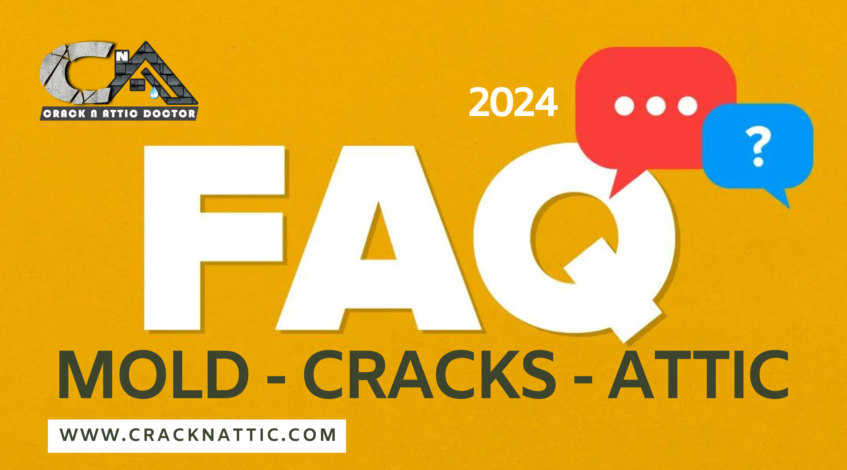Frequently Asked Questions (FAQ) – Mold – Cracks and Attic
Crack & Attic Repair FAQs
1. What causes cracks in walls, basements, and foundations?
Cracks can occur due to foundation settling, soil movement, water damage, temperature changes, and natural wear and tear. In basements, hydrostatic pressure and poor drainage can also cause cracks. Read more…
2. Are cracks in my foundation or walls dangerous?
While not all cracks are dangerous, horizontal, stair-step, or wide cracks may indicate serious structural problems. It’s essential to have them assessed by a professional to avoid further damage. Read more…
3. How do you repair cracks in foundations, walls, and basements?
We use specialized techniques like epoxy injections, polyurethane foam, and waterproofing solutions to fill and seal cracks. This helps prevent water infiltration, mold, and structural weakening. Read more…
4. What is an attic insulation top-up and why is it important?
An attic insulation top-up involves adding more insulation to your attic to improve energy efficiency, reduce heating and cooling costs, and maintain even temperatures throughout your home. Read more…
5. How do I know if my attic needs more insulation?
If you’re experiencing uneven temperatures, drafts, or high energy bills, your attic may need more insulation. Additionally, if the insulation levels in your attic are below the recommended R-value, a top-up is necessary. Read more…
6. What is attic rain and how does it affect my home?
Attic rain happens when warm, moist air from your home enters the attic and condenses on cold surfaces, leading to water damage. It typically occurs during winter months and can damage insulation, ceilings, and create mold issues. Read more…
7. How do you fix attic rain problems?
We fix attic rain issues by sealing air leaks, improving insulation, and enhancing ventilation to prevent warm air from entering the attic and condensing. This stops condensation and moisture buildup.
8. Can attic rain be prevented?
Yes, by ensuring your attic has proper insulation and ventilation, and by regularly inspecting for air leaks or moisture issues, you can prevent attic rain.
9. How long does it take to repair cracks or add insulation?
Most crack repairs can be completed in a few hours, depending on the extent of the damage. Attic insulation top-ups usually take a few hours to a day, depending on the size of the attic.
10. What type of insulation do you use for top-ups?
We use high-quality, eco-friendly insulation materials such as fiberglass and cellulose, which provide excellent thermal performance and durability.
11. How often should I inspect my basement and foundation for issues?
It’s a good idea to inspect these areas at least once a year or after extreme weather events. Regular inspections help catch potential problems early and prevent costly repairs. Read more…
12. Can you repair cracks in concrete and brick surfaces?
Yes, we specialize in repairing cracks in a variety of materials, including concrete and brick, ensuring long-lasting and durable results. Read more…
13. What are the benefits of fixing foundation cracks and upgrading attic insulation?
Repairing foundation cracks prevents structural damage, water leaks, and mold growth, while upgrading attic insulation improves energy efficiency, reduces utility costs, and enhances home comfort.
Mold Treatment FAQs
14. What are the signs of mold in my home?
Common signs include musty odors, visible dark spots, dampness, and allergy-like symptoms. Mold can grow in damp areas, such as basements, attics, and bathrooms. Read more…
15. Is mold dangerous?
Yes, mold can cause health issues, especially for those with allergies, asthma, or weakened immune systems. It can also lead to structural damage if left untreated. Read more…
16. How do you treat mold in homes?
We provide thorough mold inspections and use professional-grade mold removal and remediation techniques. We also identify and address the source of moisture to prevent future mold growth.
17. How long does mold removal take?
The time required for mold removal depends on the size and severity of the infestation. Most treatments take 1-3 days to complete. More info…
18. How can I prevent mold from returning?
To prevent mold, control moisture levels by fixing leaks, ensuring proper ventilation, and maintaining consistent indoor humidity. Regular inspections of areas prone to moisture can also help. More info…
19. Will mold treatment damage my home?
Our mold treatment process is safe and effective, and we take every precaution to minimize disruption and prevent damage to your property. More info…
20. What areas do you serve?
We proudly serve Calgary, Cochrane, Airdrie, Chestermere, Conrich, Okotoks, and High River.
General FAQs
20. How do I schedule an inspection or service?
You can schedule an appointment by calling us at (403) 321-2623 or by filling out our online contact form.


Leave a Reply